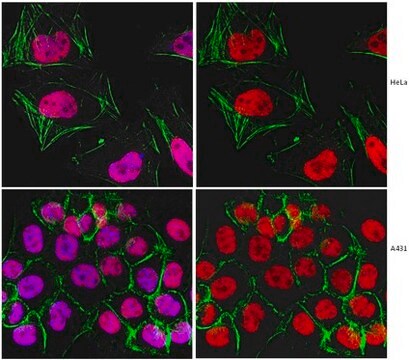The concentration of this antibody is reported on a lot specific basis. The product specification range is 6 - 12 mg/mL. A brief review of the lot history shows a typical range of 8 - 10 mg/mL. Please see the link below to review a sample or lot specific certificate:
https://www.sigmaaldrich.com/product/sigma/p2921#product-documentation
Wichtige Dokumente
P2921
Monoclonal Anti-Protein A antibody produced in mouse
clone SPA-27, ascites fluid
Synonym(e):
Monoclonal Anti-Protein A
Größe auswählen
Größe auswählen
About This Item
Empfohlene Produkte
Biologische Quelle
mouse
Qualitätsniveau
Konjugat
unconjugated
Antikörperform
ascites fluid
Antikörper-Produkttyp
primary antibodies
Klon
SPA-27, monoclonal
Enthält
15 mM sodium azide
Methode(n)
immunocytochemistry: suitable
indirect ELISA: 1:20,000
western blot: suitable
Isotyp
IgG1
Versandbedingung
dry ice
Lagertemp.
−20°C
Posttranslationale Modifikation Target
unmodified
Suchen Sie nach ähnlichen Produkten? Aufrufen Leitfaden zum Produktvergleich
Allgemeine Beschreibung
Spezifität
Immunogen
Anwendung
Biochem./physiol. Wirkung
Physikalische Form
Haftungsausschluss
Sie haben nicht das passende Produkt gefunden?
Probieren Sie unser Produkt-Auswahlhilfe. aus.
Lagerklassenschlüssel
10 - Combustible liquids
WGK
nwg
Flammpunkt (°F)
Not applicable
Flammpunkt (°C)
Not applicable
Hier finden Sie alle aktuellen Versionen:
Analysenzertifikate (COA)
Die passende Version wird nicht angezeigt?
Wenn Sie eine bestimmte Version benötigen, können Sie anhand der Lot- oder Chargennummer nach einem spezifischen Zertifikat suchen.
Besitzen Sie dieses Produkt bereits?
In der Dokumentenbibliothek finden Sie die Dokumentation zu den Produkten, die Sie kürzlich erworben haben.
-
I would like to know the concentration (mg/mL) of the anti-proA antibody. Thanks!
1 answer-
Helpful?
-
Active Filters
Unser Team von Wissenschaftlern verfügt über Erfahrung in allen Forschungsbereichen einschließlich Life Science, Materialwissenschaften, chemischer Synthese, Chromatographie, Analytik und vielen mehr..
Setzen Sie sich mit dem technischen Dienst in Verbindung.








